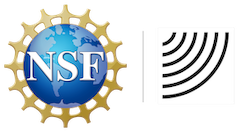Initial LIGO (iLIGO) to O4 Range Radii
Evolution of LIGO's binary neutron star (BNS) detection range between Initial LIGO (iLIGO, 2002) and O4 (2025). The base map (created by Richard Powell, Atlas of the Universe) shows the nearest superclusters of galaxies within a 500 million-light-year radius (~153 megaparsecs (Mpc)) of the Virgo Supercluster, in which our Milky Way Galaxy resides. Hundreds of thousands of large galaxies reside within this volume of space.
In its fourth observing run, O4, LIGO has achieved a BNS range of 170 Mpc (550 million light years) reaching just beyond the confines of this map. Binary neutron star mergers are among the 'weakest' gravitational wave signals that LIGO can detect, so detecting them at these great distances means that LIGO's ability to detect the much more powerful black-hole collisions will also expand to include unimaginably vast reaches of the Universe. (Credit: Galaxy map by Richard Powell. Animation: Caltech/MIT/LIGO Lab/Kim Burtnyk)
- Date
- March 18, 2025
- Location
- LIGO Lab
- ID
- iLIGOO4Range
- Type
- Education
- Credit
- Base map: http://www.atlasoftheuniverse.com/nearsc.html. Animation: Caltech/MIT/LIGO Lab/Kim Burtnyk.



